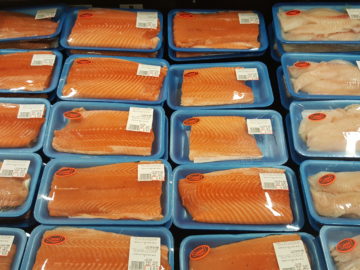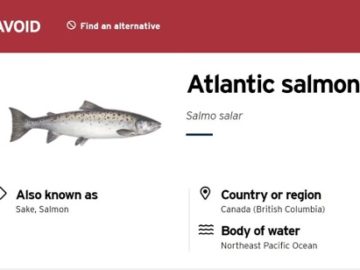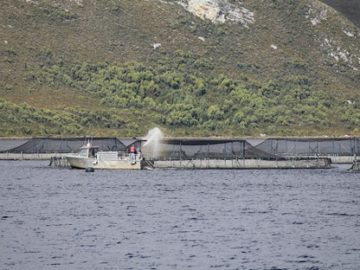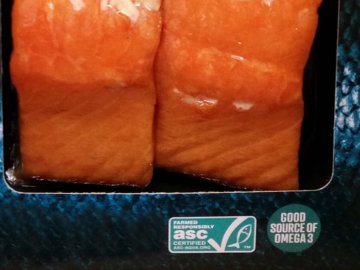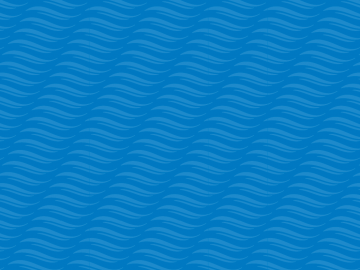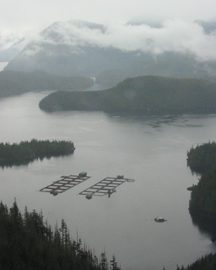What does this mean for salmon sold in your local grocer?
Back in 2020, salmon aquaculture giant Mowi Canada West (misleadingly) boasted that its B.C. salmon farms were 100 per cent certified to the so-called gold standard, Aquaculture Stewardship Certification. Fast forward to 2023 and Mowi, as well as Cermaq Canada, have dropped ASC like a hot potato.
So how did we get here and what does it mean for seafood shoppers?
Mowi, previously known as Marine Harvest, had been an active steering committee participant in the dialogues organised by World Wildlife Fund that established the ASC’s Salmon Standard. SeaChoice member groups, David Suzuki Foundation and Living Oceans, also participated in the dialogues to drive the standard’s bar for certification as high as possible.
The final standard, published in 2012, resulted in some ‘high bars’ – at least on paper – for sea lice and First Nations’ rights. The ASC seemed to be keeping their objective to certify only farms following best practice, defined as the top 15 per cent of the global industry. But that was soon to change.
Spoiler alert: the ASC now certifies around 50 per cent of the global salmon farming industry.
From 2012 to 2022, no B.C. farm should have been able to meet the 0.1 mature female sea lice per fish limit the Aquaculture Stewardship Certification required, yet the first ASC certification in Canada was awarded in 2016. It was Mowi’s Marsh Bay farm.
So how was Mowi’s Marsh Bay certified – despite sea lice levels that peaked at 23 mature sea lice per fish?
Farm auditors applied for an exemption to the sea lice limit and ASC approved it. It gets worse: ASC ignored the direct consequences to wild salmon and expanded the exemption to all B.C. farms applying for certification.
SeaChoice has called out numerous ASC certified farms with dangerously high lice loads over the years. These lice loads place wild salmon at risk and mislead consumers into thinking they are supporting sustainable farming practices. Most recently, we called out the Aquaculture Stewardship Certification’s revised sea lice criterion that dramatically increases (up to 1,550 per cent in some regions) the number of sea lice allowed on certified farms.
Other ASC shenanigans include auditors certifying farms as being ‘socially responsible’ and in compliance with the “gold-standard’s” First Nations’ rights criterion. However, these certified farms are located in the unceded territories of First Nations who vehemently oppose salmon farms.
You might think that Mowi’s withdrawal from ASC isn’t so bad, given ASC’s track record of lowering the bar for farms to become certified.
But sadly, Mowi has simply replaced ASC with an even lower bar certification, Best Aquaculture Practices.
The BAP Salmon Farms standard requires little from farms beyond the industry’s norms. BAP has no limits on sea lice, disease, chemicals or sea lion deaths.
Another thing that Best Aquaculture Practices lacks is transparency. To the Aquaculture Stewardship Certification’s credit, they require farms to publish certain data on their website, including sea lice counts, in a timely manner. When Mowi shifted to BAP, they promptly stopped publishing counts. This limits the ability of the public, stakeholders and independent scientists to monitor (in as close to real time as possible during the juvenile wild salmon migration) what is happening on farms. Convenient, no?
So, what does this all mean for seafood shoppers?
No matter what faulty certification the salmon farmers use – all fail to protect wild salmon from disease and sea lice.
Summed up: while salmon farmers are switching from bad to worse certifications, they still remain on the ‘avoid’ list.
SeaChoice recently assessed the farmed salmon policies of Canadian grocers and the major brands they sell. We found nearly all rely on ASC and/or BAP certification to sell open-net pen farmed salmon.
Tell your grocer these certifications don’t cut it and to stop selling open-net pen salmon on our Seafood Progress platform.
